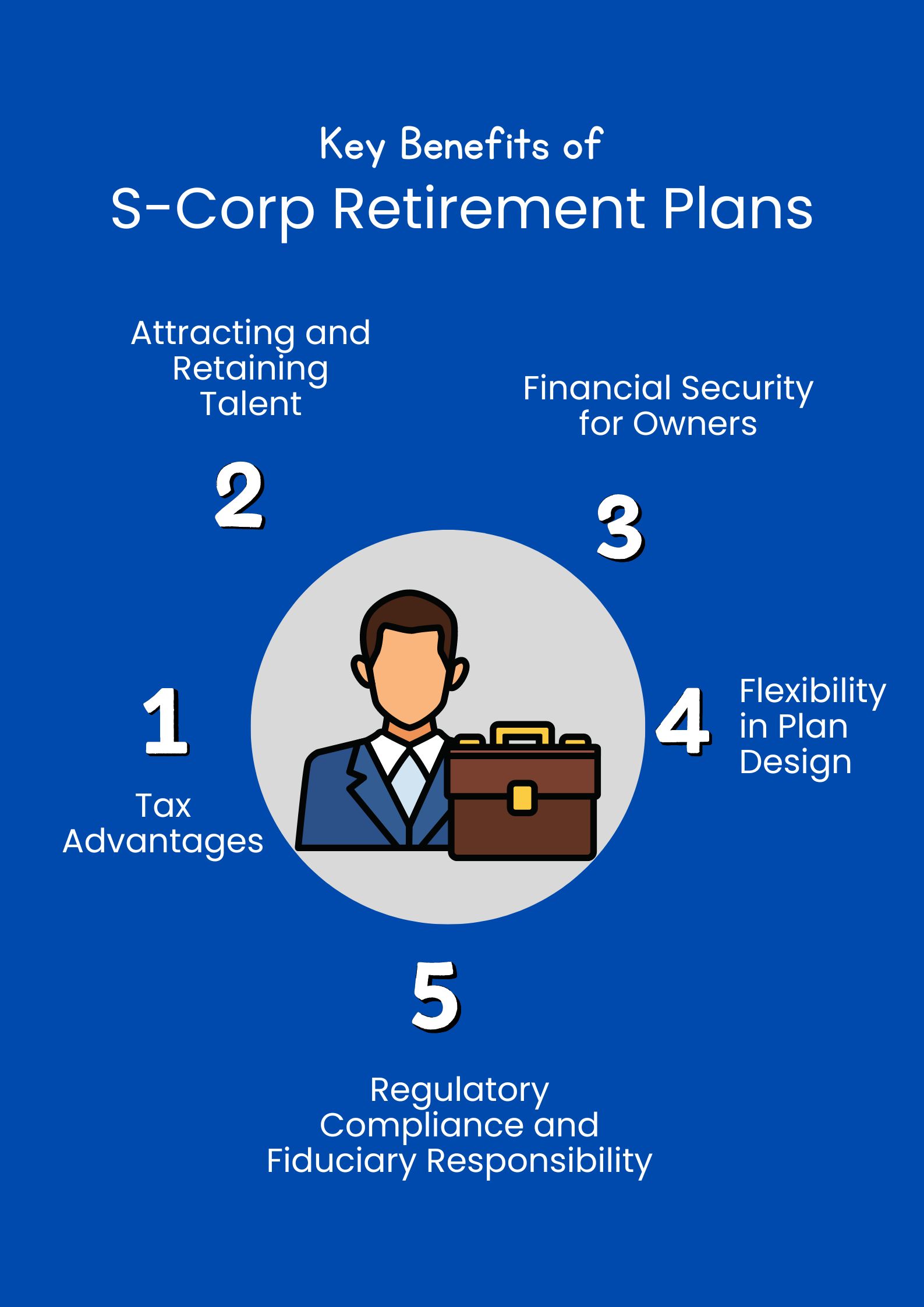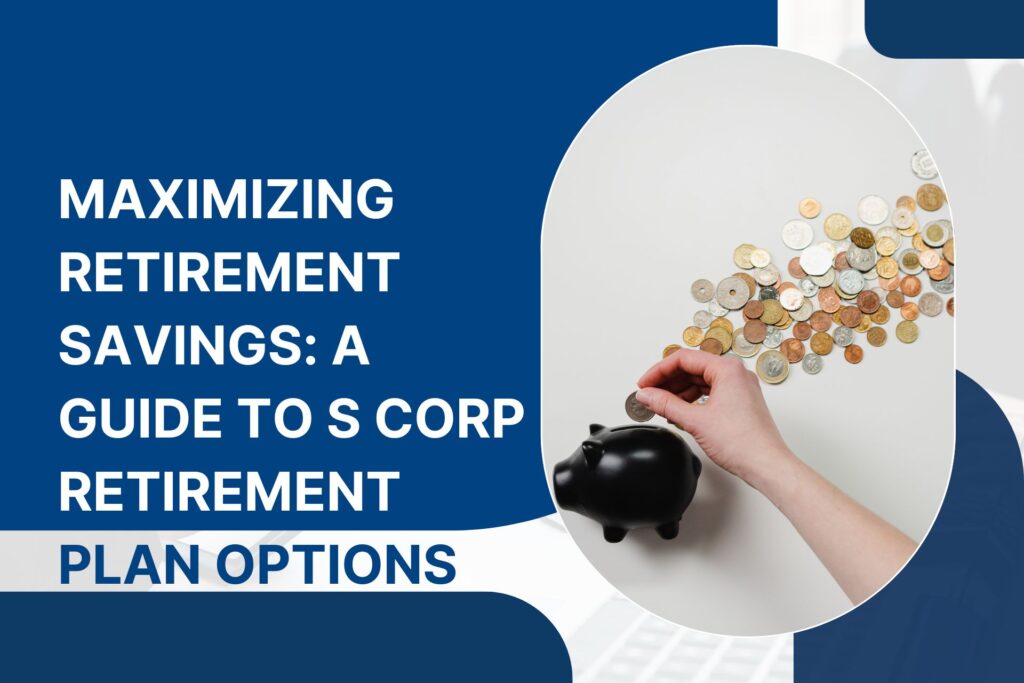As a business owner, you have the unique opportunity to maximize your retirement savings through a variety of retirement plan options. But with so many choices available, it can be challenging to know which plan is best for you. That’s where this guide comes in.
In this comprehensive resource, we’ll explore the various S Corp retirement plan options available to you and provide guidance on how to choose the one that best fits your needs.
We’ll cover everything from traditional 401(k) plans to SEP IRAs and SIMPLE IRAs, explaining the pros and cons of each and helping you weigh the costs and benefits. By the end of this guide, you’ll have a solid understanding of the different S Corp retirement plan options available to you and be well on your way to maximizing your retirement savings. So let’s dive in!
Benefits of S Corp Retirement Plans
One of the biggest advantages of working for an S corporation is the variety of retirement plan options available to you. These plans are designed to help you save for retirement while also providing tax benefits and potential employer contributions. By participating in an S corp retirement plan, you can:
– Save more money for retirement: Retirement plans allow you to set aside a portion of your income each year, which can add up to significant savings over time. Depending on the plan you choose, you may be able to contribute more money than you would be able to with an individual retirement account (IRA).
– Enjoy tax benefits: Many retirement plans offer tax benefits, such as the ability to deduct your contributions from your taxable income. This can help reduce your tax bill each year and leave you with more money to save for retirement.
– Receive employer contributions: If your S corporation offers a matching contribution or profit-sharing plan, you can receive additional funds to help boost your retirement savings.

Overall, S corp retirement plans offer a great way to save for retirement while also taking advantage of tax benefits and employer contributions. But with so many different retirement plan options available, it can be challenging to know which one is right for you. Let’s explore the different types of S corp retirement plans and their pros and cons.
Types of S Corp Retirement Plans
There are several different types of S corp retirement plans available, each with its own unique features and benefits. Let’s take a closer look at some of the most popular options:
Simplified Employee Pension (SEP) IRA
A Simplified Employee Pension (SEP) IRA is a retirement plan that allows employers to make contributions to their employees’ retirement accounts. As an S corporation employee, you can participate in a SEP IRA and contribute up to 25% of your compensation each year, up to a maximum limit specified by the IRS each year. These contributions are tax-deductible, which means that you can reduce your taxable income each year by the amount of your contribution.
One of the biggest advantages of a SEP IRA is its simplicity. There are no complex administrative requirements, and employers can set up and contribute to the plan on a year-to-year basis. However, because the employer makes all of the contributions, there is no opportunity for employee contributions or catch-up contributions for those over 50. Additionally, because the contributions are made on a percentage basis, employees with higher salaries will receive larger contributions.
Savings Incentive Match Plan for Employees (SIMPLE) IRA
A Savings Incentive Match Plan for Employees (SIMPLE) IRA is another retirement plan option available to S corporation employees. Like a SEP IRA, a SIMPLE IRA allows employers to make contributions to their employees’ retirement accounts. However, with a SIMPLE IRA, employees can also make their own contributions, up to a maximum amount specified by the IRS each year (plus catch-up contributions for those over 50). Employers can choose to either match employee contributions up to 3% of their compensation or make a non-elective contribution of 2% of each employee’s compensation.
One of the advantages of a SIMPLE IRA is that it offers more flexibility than a SEP IRA. Employees can make their own contributions, which can help boost their retirement savings. Additionally, the employer contributions can be either a match or a non-elective contribution, which gives employers more options for how to structure the plan. However, like a SEP IRA, the contributions are made on a percentage basis, which means that employees with higher salaries will receive larger contributions.
Solo 401(k) Retirement Plan
If you’re a self-employed S corporation owner, a Solo 401(k) retirement plan may be a good option for you. This plan allows you to make both employee and employer contributions, up to a maximum amount specified by the IRS each year (plus catch-up contributions for those over 50).
One of the biggest advantages of a Solo 401(k) is its high contribution limit. As a self-employed individual, you can contribute more to a Solo 401(k) than you would be able to with other retirement plan options. Additionally, you can borrow from the plan if necessary, which can be helpful if you need access to cash in an emergency. However, Solo 401(k) plans can be more complex to administer than other retirement plans, and you may need to hire a third-party administrator to help you set up and maintain the plan.
Defined Benefit Pension Plan
A Defined Benefit Pension Plan is a retirement plan that promises a specific benefit amount to employees upon retirement. As an S corporation employee, you can participate in a Defined Benefit Pension Plan if your employer offers one. The amount of your benefit is based on a formula that takes into account your years of service and your salary history.
One of the advantages of a Defined Benefit Pension Plan is that it provides a guaranteed retirement benefit, which can be reassuring for employees who are worried about running out of money in retirement. Additionally, because the employer is responsible for funding the plan, employees don’t have to worry about making their own contributions. However, Defined Benefit Pension Plans can be complex to administer and may require actuarial calculations to determine the appropriate funding level.
How to Choose the Right S Corp Retirement Plan
With so many different retirement plan options available, it can be challenging to know which one is right for you. When choosing an S corp retirement plan, here are some factors to consider:
– Contribution limits: How much can you contribute to the plan each year, and how does that compare to other retirement plan options?
– Tax benefits: What tax benefits does the plan offer, and how much can you save on your taxes each year by participating in the plan?
– Employer contributions: Does your employer offer matching contributions or profit-sharing contributions, and how much can you expect to receive?
– Administrative requirements: How complex is the plan to administer, and will you need to hire a third-party administrator to help you manage it?
– Investment options: What investment options are available through the plan, and how do they compare to other investment options available to you?
By considering these factors, you can choose the S corp retirement plan that best fits your needs and helps you maximize your retirement savings.
Contribution Limits and Tax Benefits
One of the biggest advantages of S corp retirement plans is the tax benefits they offer. Depending on the plan you choose, you may be able to deduct your contributions from your taxable income, which can help reduce your tax bill each year. Additionally, many plans offer tax-deferred growth, which means that you won’t pay taxes on your contributions or investment earnings until you withdraw the money in retirement.
The contribution limits for S corp retirement plans vary depending on the plan you choose. It’s important to note that contribution limits can change from year to year, so be sure to check the IRS website for the latest information.
S Corp Retirement Plan Compliance and Administration
One of the challenges of S corp retirement plans is ensuring compliance with IRS regulations. Retirement plans are subject to strict rules and regulations, and failure to comply can result in penalties and fines. Additionally, retirement plans can be complex to administer, especially if you have a larger number of employees.
To ensure compliance with IRS regulations and simplify plan administration, many S corporations choose to work with a third-party administrator. A third-party administrator can help ensure that your retirement plan is in compliance, handle plan administration tasks, and provide education and support to plan participants.
Common Mistakes to Avoid
When it comes to S corp retirement plans, there are several common mistakes that employees and employers make. Here are a few to watch out for:
– Not contributing enough to the plan: To maximize your retirement savings, it’s important to contribute as much as you can to your retirement plan each year. If you’re able to make catch-up contributions, be sure to take advantage of that opportunity.
– Failing to comply with IRS regulations: Retirement plans are subject to strict rules and regulations, and failure to comply can result in penalties and fines. Be sure to work with a third-party administrator or other professional to ensure that your plan is in compliance.
– Not reviewing the plan regularly: Retirement plans can change from year to year, so it’s important to review your plan regularly to ensure that it still meets your needs. Consider meeting with a financial advisor or other professional to review your plan and make any necessary adjustments.
Conclusion
As an employee of an S corporation, you have a variety of retirement plan options available to you. By choosing the right plan and maximizing your contributions, you can save more money for retirement while also taking advantage of tax benefits and potential employer contributions. Whether you choose a SEP IRA, SIMPLE IRA, Solo 401(k), or Defined Benefit Pension Plan, be sure to consider your contribution limits, tax benefits, and administrative requirements when making your decision. With careful planning and the help of a professional, you can ensure that your retirement plan meets your needs and helps you achieve your retirement goals.


